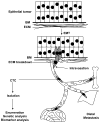Circulating tumor cells: a window into cancer biology and metastasis
- PMID: 20071161
- PMCID: PMC2846729
- DOI: 10.1016/j.gde.2009.12.002
Circulating tumor cells: a window into cancer biology and metastasis
Abstract
The presence of circulating tumor cells (CTCs) accompanies tumor invasion into the bloodstream. Detection, monitoring, and molecular analysis of these rare cancer cells shed into blood will provide a powerful and noninvasive approach for the detection of early disease, assessing prognosis and therapeutic response in established cancers, and targeting metastatic precursor cells. We review current and emerging technologies for CTC isolation, with a focus on capture efficiency, purity, and viability of CTCs, and their potential clinical applications.
Copyright 2009 Elsevier Ltd. All rights reserved.
Figures

References
-
- Allard WJ, Matera J, Miller MC, Repollet M, Connelly MC, Rao C, Tibbe AG, Uhr JW, Terstappen LW. Tumor cells circulate in the peripheral blood of all major carcinomas but not in healthy subjects or patients with nonmalignant diseases. Clin Cancer Res. 2004;10:6897–6904. - PubMed
-
- Cristofanilli M, Budd GT, Ellis MJ, Stopeck A, Matera J, Miller MC, Reuben JM, Doyle GV, Allard WJ, Terstappen LW, Hayes DF. Circulating tumor cells, disease progression, and survival in metastatic breast cancer. N Engl J Med. 2004;351:781–791. - PubMed
-
- Cristofanilli M, Hayes DF, Budd GT, Ellis MJ, Stopeck A, Reuben JM, Doyle GV, Matera J, Allard WJ, Miller MC, et al. Circulating tumor cells: a novel prognostic factor for newly diagnosed metastatic breast cancer. J Clin Oncol. 2005;23:1420–1430. - PubMed
-
- Danila DC, Heller G, Gignac GA, Gonzalez-Espinoza R, Anand A, Tanaka E, Lilja H, Schwartz L, Larson S, Fleisher M, Scher HI. Circulating tumor cell number and prognosis in progressive castration-resistant prostate cancer. Clin Cancer Res. 2007;13:7053–7058. Using the Veridex immunomagnetic CTC isolation technology, the authors demonstrate that baseline CTC numbers are predictive of prostate cancer survival. The results were consistent with the observations reported in breast cancer. - PubMed
-
- He W, Wang H, Hartmann LC, Cheng JX, Low PS. In vivo quantitation of rare circulating tumor cells by multiphoton intravital flow cytometry. Proc Natl Acad Sci U S A. 2007;104:11760–11765. This manuscript describes a sensitive, and noninvasive technology that involves multiphoton fluorescence imaging of superficial blood vessels to quantify flowing CTCs following the injection of a tumor-specific fluorescent ligand. - PMC - PubMed
Publication types
MeSH terms
Substances
Grants and funding
LinkOut - more resources
Full Text Sources
Other Literature Sources

